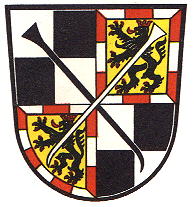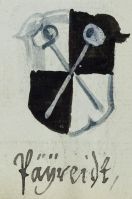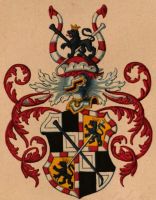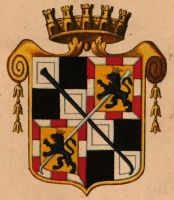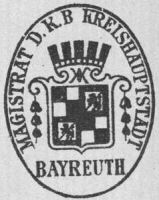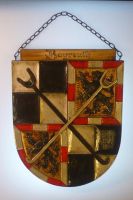Bayreuth
|
Country : Germany State : Bayern District (Kreis) : Bayreuth Urban District (Kreisfreie Stadt) Additions:
|
| German | Geviert und überdeckt mit zwei schräg gekreuzten Reuten, die rechte schwarz, die linke silbern; 1 und 4 wieder geviert von Silber und Schwarz; 2 und 3 in Gold mit von Rot und Silber gestücktem Bord ein rot gekrönter und rot bewehrter schwarzer Löwe. |
| English | blazon wanted |
Origin/meaning
Bayreuth was acquired in 1248 by the Margraves of Nürnberg and was already considered a city since 1231. The oldest seal of the city dates from 1429 and shows a shield with two sticks. The sticks are some farmer's tool and are named Reut in German, the arms are thus canting (two Reuten). The sticks also appear on the coins of the city in the 15th century.
Already in the 15th century the two sticks were placed on the quartered black and silver arms of the margraves form the Hohenzollern dynasty. On December 22, 1457 Margrave Albrecht Achilles officially granted the city the present arms, but with, as was usual at the time, the mantling, helmet and crest of the family (see image below). The arms thus show the arms of the dynasty (black and white quartering), the lion as the arms of the State of Nürnberg and the two sticks.
Already in the same year the arms appeared on the new seal of the city. The arms remained unchanged until 1810, when the city became part of Bayern. All references to the older states had to be removed, or changed. For Bayreuth it meant that the black and silver quarters were changed into blue and silver (the Bavarian colours) and that the black lion in the crest also changed into blue. The crest also was replaced by a mural crown to avoid the crest of the former ruler. These colours were used until 1840. In the late 19th century the historical colours were restored. The mantling, crest and helmet were officially removed in 1928, but are still sometimes used.
The meaning of the sticks had faded during the centuries and thus the sticks were shown in many different ways. In 1811 they were even shown as two bones..., or, as in the image below from Hupp at the end of the 19th century, as a kind of fork.
The arms in a 16th century manuscript
The arms by Hupp in the Kaffee Hag albums +/- 1925
The arms in the Deutsches Wappenmuseum
The arms on a card, 1977
with Annecy
Literature: Stadler, 1990; Kaffee Hag albums 1920s.
This page is part of the German heraldry portal Deutsche Wappensammlung |
Heraldry of the World |
|
German heraldry:
|
Selected collector's items from Germany:
|
Contact and Support
Partners:
Your logo here ?
Contact us
© since 1995, Heraldry of the World, Ralf Hartemink 
Index of the site
